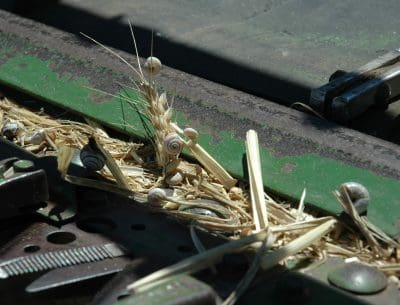GRAIN growers are encouraged to implement strategies to avoid snail contamination of grain this harvest.

At harvest, snails present in the crop canopy (or windrows) above cutting height can often enter the header, clogging machinery and/or leading to downgraded grain quality.
The South Australian Research and Development Institute (SARDI) Entomology Unit advises that recent wet weather has favoured increased activity in snails and slugs in maturing crops, and snails are reportedly moving into crop canopies.
SARDI entomologist, Bill Kimber, whose work is supported by the Grains Research and Development Corporation (GRDC), said snails presented above cutting height in the canopy or in windrows could enter the header during harvest, potentially leading to clogging of machinery and grain quality downgrades.
“Closely monitoring snail populations ahead of harvest is recommended so growers can determine the need for measures, such as header modifications, to reduce the risk of contamination,” Mr Kimber said.
Tactics for minimising snail contamination of grain at harvest include:
- Harvesting snail-infested crops first where possible before all snails have moved into the canopy. Early harvesting after moisture has triggered snail movement down plants can help reduce snail intake without excessive grain moisture absorption;
- Monitoring levels of snail contamination in higher risk areas such as paddock perimeters and if necessary, harvesting and storing these areas separately to avoid mixing contaminated grain with snail-free grain;
- Windrowing cereal crops can dislodge some round snails. However, snails tend to invade windrows of crops that are cut green and left to dry (such as canola and pulses);
- Dislodger bars attached to the header will knock a proportion of round snails from standing crops. These are often most effective in early harvested or windrowed crops. The design should be adjusted for different crop types and conditions to maximise snail removal while minimising grain losses. Travelling at right angles to the direction of crop lean where possible can further reduce losses;
- Stripper fronts can significantly reduce snail intake in cereal crops relative to standard open front machines. They also allow faster harvest speeds and will smash some snails as they enter the header. Raising the cutting height is a cheaper but less effective option. Both methods leave more standing straw but this may be removed with a second pass;
- Sieves and mesh screens should be set up correctly to maximise snail and grain separation within the header. Sheet metal (punch-hole and expanded mesh) sieves are usually more effective than louvre sieves in removing snails but have a lower cleaning throughput, therefore harvest speed may need to be reduced to avoid overloading and grain losses. Where large numbers of snails are entering the harvester consider the use of a couple of loose chains securely attached to the top of the sieve to limit snails gumming up the sieve;
- Post-harvest grain cleaning is the last opportunity for snail removal. A combination of cleaning systems and rollers is often required to meet receival standards without excessive grain losses. Rolling involves crushing snails in the grain and is effective for all hard grains at the optimal moisture content. The roller clearance needs to be adjusted to ensure snails are crushed while avoiding grain damage. Additional care must be taken when rolling canola to adjust plastic-coated steel rollers and regulate canola flow rates in order not to crack the grain.
Growers are reminded that the common white snail (Cernuella virgata) is a prohibited pest in important export markets, therefore it is vital that grain is delivered free of snails to maintain market access.
Mr Kimber said that following harvest, summer management was a key part of a year-round approach to effectively manage snail populations.
“It is important to control summer weeds to remove refuges before undertaking other cultural control methods,” he said.
“Bashing stubble on hot days (above 35°C) will dehydrate and kill some snails. Burning in autumn can achieve high snail mortality but this should be balanced against the risk of erosion.
“Burning only chaff rows reduces the risk of erosion and snails are attracted to moisture under these windrows. Instead of spreading chaff and straw at harvest, consider burning these as autumn conditions allow as part of a snail control program. Baiting before egg lay in late summer/early autumn is critical.”
The GRDC has published a Snail Management Fact Sheet which can be viewed and downloaded via www.grdc.com.au/GRDC-FS-SnailManagement. It provides information on minimising contamination at harvest as part of a year-round approach to controlling snails.
More information on harvest techniques and integrated snail management is contained in the GRDC publication Bash ’em, Burn ’em, Bait ’em which is available for viewing and download via www.grdc.com.au/GRDC-Snails-BashBurnBait.
Meanwhile, grains industry leaders in SA have formed a working group to highlight the importance of continued grain hygiene to Keep Our Grain Clean to enable continued access to international and domestic markets.
The group, headed by the Grain Industry Association of South Australia (GIASA) which represents all grain marketing organisations in the State, is supported by grower advocacy group Grain Producers SA (GPSA), Grain Growers Ltd, the state’s largest bulk handler Viterra, Grain Corp, the South Australian Grain Industry Trust (SAGIT), the GRDC, Primary Industries and Regions SA (PIRSA), and fodder industry and independent agronomy consultants.
More information on grain quality and hygiene requirements are available through the GRDC, Viterra, PIRSA and other sources online at www.pir.sa.gov.au/cleangrain.
Source: GRDC

HAVE YOUR SAY